Inflight Magazine of Brussels Airlines
Welcome to the Inflight Magazine of Brussels Airlines
Malaga munchies
MUNCING IN Malaga
With the grape harvest in full swing, Heidi Fuller-Love hikes the squid trail, sups garlic soup, takes cookery lessons, chills out in a bodega and fi nds out what puts the ‘mmmm’ in Malaga
Dial for Spain
 Signed by the seafaring Phoenicians, sealed by the sophisticated Moors and delivered, with a briny kiss, by the blue seas and shimmering skies that make long, lazy lunches an obligation, Malagueño cuisine is a rich fusion of traditional munching, snack zapping and culinary questing that pays handsome tribute to the Mediterranean diet.
Signed by the seafaring Phoenicians, sealed by the sophisticated Moors and delivered, with a briny kiss, by the blue seas and shimmering skies that make long, lazy lunches an obligation, Malagueño cuisine is a rich fusion of traditional munching, snack zapping and culinary questing that pays handsome tribute to the Mediterranean diet.
“The city of Malaga has changed a lot over the past few years. We’ve always had a lot of good restaurants serving local specialities, but now we also have a lot of new places serving a more innovative cuisine based on many of those ‘old favourites’,” says Gabriel Quesada of Hotel Larios (2 Calle Marqués de Larios, tel. ), a boutique establishment in the town’s historic centre, which has a gourmet restaurant of its own.
Founded in 1,000BC, Malaga derives its name from the Phoenician ‘malac’ meaning ‘to salt’. Early inhabitants used to salt fish in the habour, and seafood is still top of the menu in most of the city’s chiringuitos (seafront cafés), bodegas (converted warehouses) and bars, not to mention ventas, cervecerias and tascas.
Chanquetes (tiny anchovies marinated in vinegar) and gambas pil pil (spicy flash-fried prawns) are popular entrées. Main dishes include espetos de sardines (sardines roasted on bamboo spits), adobo (swordfish marinated in wine) and the city’s signature dish pescaíto frito, a mixed platter of fish fried in crispy batter.
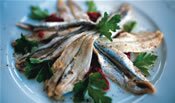 The subtropical climate ensures plenty of exotic fruit and vegetables, from butter-soft avocados to bitter-sweet nisperos, find their way to the table. Cool soups, such as the ubiquitous gazpacho and ajo blanco (almond and garlic) are also common staples.
The subtropical climate ensures plenty of exotic fruit and vegetables, from butter-soft avocados to bitter-sweet nisperos, find their way to the table. Cool soups, such as the ubiquitous gazpacho and ajo blanco (almond and garlic) are also common staples.
“Each village of the Malaga province has its speciality and you’ll find most of them on the menu in the city,” says Pedro Lopez from La Antigua Casa de Guardia, one of Malaga’s oldest bodegas. “Rabbit and tomato stew is a speciality from Mijas. Salmorejo, a thick version of gazpacho, is from Istán. Borrachuelos, which are a bit like rum babas soaked in wine, originated somewhere near Antequera, and aguardiente, our local firewater made from grapes, comes from Ojen.
“Up in the mountains it gets chilly in winter, so they make dishes using earthier ingredients, such as chorizo and morcilla [blood sausage],” Lopez adds. “Another mountain speciality is migas, a dish made from herbs and breadcrumbs that’s said to have evolved from the bread and tortillas left over from breakfast. This is celebrated with a migas festival every year in the town of Torrox.”
Hit the tapas trail
 Tapas originated in Andalusia, where a combination of heat and poverty made grazing a way of life. Malaga’s annual tapas festival is the place to sample higado (chopped liver served in a tomato sauce), lomo embuchado (sausage skin stuffed with cured pork), albóndigas de atún (tuna balls), esparragos de marisco (seafood asparagus) and other highlights of the region’s emblematic finger food.
Tapas originated in Andalusia, where a combination of heat and poverty made grazing a way of life. Malaga’s annual tapas festival is the place to sample higado (chopped liver served in a tomato sauce), lomo embuchado (sausage skin stuffed with cured pork), albóndigas de atún (tuna balls), esparragos de marisco (seafood asparagus) and other highlights of the region’s emblematic finger food.
“For three days and nights we do nothing but drink and nibble,” says Juan Herrero, one of the festival’s organisers. “If you like tapas, you’ll love this fiesta.”
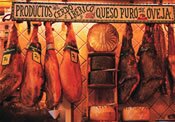 Sticking with the snack theme, the city’s hotel association has put together three fish-focused tapas trails, linking a line of chiringuitos to the east and west of town. Tentacles are top of the menu along the ‘squid trail’, which stretches from the sun-loungers of Misericordia beach to the tower blocks of Torremolinos. The ‘anchovy trail’ leads from the port district of El Palo to the cliffs of Peñón del Cuervo, while the ‘sardine trail’ glides from El Pedregalejo fishing district to the laidback seaside resort of Rincon de la Victoria.
Sticking with the snack theme, the city’s hotel association has put together three fish-focused tapas trails, linking a line of chiringuitos to the east and west of town. Tentacles are top of the menu along the ‘squid trail’, which stretches from the sun-loungers of Misericordia beach to the tower blocks of Torremolinos. The ‘anchovy trail’ leads from the port district of El Palo to the cliffs of Peñón del Cuervo, while the ‘sardine trail’ glides from El Pedregalejo fishing district to the laidback seaside resort of Rincon de la Victoria.
Get to grips with the grape
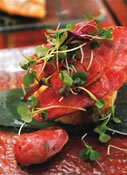 Malaga’s wine trade dates back to Roman times, and its Winemakers’ Guild, founded in 1487, is one of the oldest in Spain. Only wine aged in casks within the perimeters of the city can claim that coveted Malaga label.
Malaga’s wine trade dates back to Roman times, and its Winemakers’ Guild, founded in 1487, is one of the oldest in Spain. Only wine aged in casks within the perimeters of the city can claim that coveted Malaga label.
Moscatel and Pedro Ximénez grapes are grown and pressed in the province’s villages, and every September the hills around Malaga are alive to the sound of vendimias (grape harvests), which are also the excuse for boozy festivals such as Cómpeta’s Noche del Vino, where the fountains gush wine and visitors help tread the grapes.
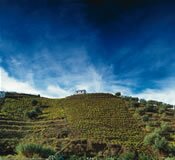 To sup wine in the city, head for El Pimpi (62 Calle Granada, tel. ), a bustling bodega in Malaga’s historic quarter, where the wine barrels are scrawled with the signatures of Pedro Almodóvar, Antonio Banderas and other celebrities who hang out there when in town. Founded 150 years ago, La Antigua Casa de Guardia (18 Alameda Principal, tel. ) is another popular local watering hole, where sea urchin and other briny snacks are served with Malaga’s finest wines drawn straight from the barrel.
To sup wine in the city, head for El Pimpi (62 Calle Granada, tel. ), a bustling bodega in Malaga’s historic quarter, where the wine barrels are scrawled with the signatures of Pedro Almodóvar, Antonio Banderas and other celebrities who hang out there when in town. Founded 150 years ago, La Antigua Casa de Guardia (18 Alameda Principal, tel. ) is another popular local watering hole, where sea urchin and other briny snacks are served with Malaga’s finest wines drawn straight from the barrel.
Sweet satisfaction
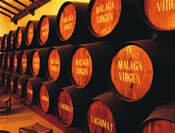 Malaga is famed for its sticky desserts brought to town by those sweet-toothed Moors, and has some A-list pastry shops. Lepanto (7 Calle Marqués de Larios, tel. ) is the place to sip fragrant coffee and sup on traditional almond and honey polvorones (cookies), while Casa Mira (5 Calle Marqués de Larios, tel. ) is the city’s hottest address for churros, sugary pastries served with cups of creamy chocolate.
Malaga is famed for its sticky desserts brought to town by those sweet-toothed Moors, and has some A-list pastry shops. Lepanto (7 Calle Marqués de Larios, tel. ) is the place to sip fragrant coffee and sup on traditional almond and honey polvorones (cookies), while Casa Mira (5 Calle Marqués de Larios, tel. ) is the city’s hottest address for churros, sugary pastries served with cups of creamy chocolate.
Best new Malaga eating
Casa Angel
29 Calle Madre de Dios, tel. , www.lacasadelangel.com Angel Garo, Spanish comedy king turned chef, delivers inventive local cuisine in this restaurant packed to the gills with the owner’s collection of antique knick-knacks
Palocortado
4 Avenida Príes, tel. , www.palocortado.com Chef Miguel Palma works wonders with age old treats in this hip new feeding venue.
Chef recommends
 Mike Powell is an adept of Malagueño cuisine since the 70s when he opened his fine-food restaurant La Cascada Verde in Marbella and now runs cookery courses at El Molino del Conde (www.elmolinospain.com), an ambience-packed country hotel near Malaga.
Mike Powell is an adept of Malagueño cuisine since the 70s when he opened his fine-food restaurant La Cascada Verde in Marbella and now runs cookery courses at El Molino del Conde (www.elmolinospain.com), an ambience-packed country hotel near Malaga.
“I’m absolutely passionate about Spanish food – its freshness, its historical legacy left by the Moors and the quintessential flavours of southern Spain, the Mediterranean diet at its best,” he says. “Food is central to the Spanish way of life, so guests on our cookery vacations don’t just learn to cook Malagueño style, they’re infused with Spanish culture as well. Time magazine recently said Spain was the new food mecca for culinary pilgrims – I think that’s true.”
Powell recommends El Cabra and Restaurante Antonio Martín in Malaga city for fresh fish, and Restaurante Don Curro in Antequera for local specialities.
“If you want to take something home, it has to be Cómpeta sweet dessert wine. Or a sweet or dry wine from Museo del Vino in Ronda [tel. ],” he says.
To find out more about Mike Powell’s Malagueño cuisine courses, visit www.aflavourofspain.ca.
Food fiestas
September:
■ Fiesta del Ajoblanco Almáchar (www.almachar.es)
■ Feria de Viñeros Moclinejo (www.moclinejo.es)
■ Día de la Pasa El Borge (www.elborge.es)
Rest of the year
■ July: Festival de la Tapa, Malaga (www.malagatourismo.com)
■ August: Preludio a la Noche del Vino Cómpeta (www.competa.es)
■ December: Fiesta de las Migas Torrox (www.torrox.es)
Wine school
Learn more about Malaga’s wine
Take a two-hour wine-tasting course at Museo del Vino Malaga in Ojen (39 Calle Carrera, tel. ), which has 200 bottled wine varieties from 14 of Malaga’s main wineries.
FR>> Manger à Malaga
La cuisine de Malaga est un mélange riche de recherche culinaire. Les produits de la mer sont à l’honneur avec les anchois marinés dans le vinaigre et un plat de crevettes épicé appelé gambas pilpil parmi les entrées populaires. Dans les plats principaux, on retrouve les sardines grillées sur brochettes en bambou et un plat de poisson frais frit dans une pâte croustillante – la spécialité de la ville.
Grâce au climat subtropical, une grande variété de légumes et de fruits exotiques trouve le chemin des assiettes, aux côtés des classiques gazpacho et ajo blanco, un mélange crémeux d’amandes et d’ail.
Chaque village possède sa spécialité : le ragoût de lapin et tomates à Mijas, le baba au rhum à Antequera et l’eau-de-vie locale à Ojen. Dans les montagnes, ils utilisent des mets moins sophistiqués comme le chorizo, la morcilla ou les migas – un plat à base d’herbes aromatiques et de miettes de pain, auquel le village de Torrox a dédié une fête.
Le festival annuel des tapas de Malaga est l’endroit idéal pour goûter le foie en sauce tomate ou la saucisse farcie au porc salé. Il y a aussi des circuits tapas. Suivez la piste Calamars de Misericordia à Torremolinos, la piste Anchois d’El Palo à Peñón del Cuervo ou la piste Sardines d’El pedregalejo, le quartier des pêcheurs, à Rincon de la Victoria.
Les cépages Moscatel et Pedro Ximénez sont la base de l’industrie locale du vin. Dégustez-les au El Pimpi à Malaga ou lors de la fiesta del vino à Competa.
Lepanto est le lieu idéal pour goûter les traditionnels gâteaux au miel et aux amandes, tandis que la Casa Mira propose des pâtisseries accompagnées de tasses de chocolat épais.
NL>> Mmmm, Malaga!
De keuken van Malaga is een culinaire smeltkroes. Vis en schaaldieren staan bovenaan op het menu. Neem als voorgerecht in azijn gemarineerde ansjovis of de pikante gambas pilpil. Lekkere hoofdschotels zijn de sardines geroosterd op bamboespiesen en het typische bord gefrituurde verse vis.
Een subtropisch klimaat levert niet alleen veel exotisch fruit op, maar ook flink wat groenten. Populair zijn gazpacho (koude soep) en ajo blanco, een romige amandel-lookmengeling.
Elk dorp heeft zo zijn eigen specialiteit: stoofpot van konijn met tomaten in Mijas, rumgebakjes in Antequera en het plaatselijke vuurwater van Ojen. In de bergen gebruiken ze ‘aardsere’ ingrediënten als chorizo en morcilla (bloedworst), of migas, een schotel op basis van kruiden en broodkruim, die in de stad Torrox wordt gevierd met een heuse fiesta.
Het jaarlijkse tapasfestival van Malaga is ideaal om fijngehakte lever in tomatensaus of worsten van gerookt varkensvlees te proberen. Er zijn ook tapaswandelingen. Volg de Inktvisroute van Misericordia naar Torremolinos, de Ansjovisroute van El Palo naar Peñon of de Sardineroute van de visserswijk El Pedregalejo naar Rincon de la Victoria.
De druiven Moscatel en Pedro Ximénez vormen de basis voor lekkere streekwijnen. Probeer ze bij El Pimpi in Malaga-stad of tijdens het fiesta del vino in Competa.
Voor traditionele amandelcakes met honing moet je in Lepanto zijn, terwijl de Casa Mira zoete gebakjes serveert met romige chocolademelk.
Leave a Reply
